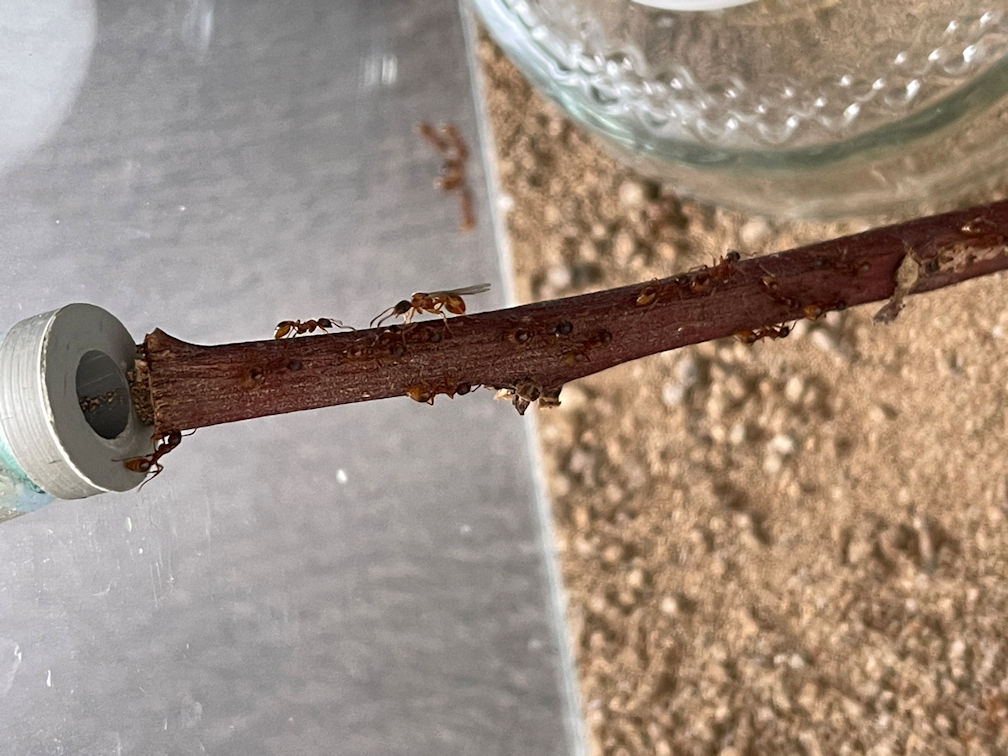In my previous blog entry I stated that my Lasius umbratus had not produced any eggs this year. Well, I was wrong.
Lasius umbratus
I wanted to check on the soil within the nesting box, to make sure it was not too dry. As I lifted the lid I received a nice surpise; there were a clutch of larvae and cocoons on the surface of the soil. These were very quickly removed by the annoyed workers, but it told me that my fears of the queen’s egg-laying having ceased were unfounded. The number of larvae and cocoons present were very small, but it does give me hope. However, if these eggs produce nothing but wingled males, then I will know that the queen’s stored sperm supply has been exhausted, which does eventually happen in older queens. Male ants are produced from unfertilised eggs.
A few days later I checked again and could not see the cocoons, either on the surface or within the nest. They may have hatched already, or, due to the number of cocoons being so small, they could have been easily placed out of sight.
Lasius niger
This colony remains very active. They tend not to send out many workers, even when fresh food is food – perhaps no more than 12-15 ants. However, when I look inside the nest I can see many more ants. There are also many larvae and cocoons present. It seems to me that this colony is now entering the first of the exponential population growth phases, which new colonies tend to experience after their first year or two.
I could not see the queen, she is well hidden away. However, it’s obvious that she is alive and well.
Myrmica rubra
I just checked on this colony, and was pleasantly surprised at the number of larvae and pupae present. In almost every chamber of the nest there is brood present. I can also see at least two winged virgin queens.
Plenty of activity out in the field, as it were, with large numbers of workers out in the foraging tank seemingly 24/7. They are eating a lot of food.

Black Ant Identification
Last week I was sent a video of an ant that somebody wished me to identify. Looking at the ant I initially suggested Lasius fuliginosus, but now that I have watched it numerous times, I am not so sure. Here are my initial thoughts on the species.
Lasius niger – quite often the “go to” species when trying to identify a black ant species in the UK. However, I am not convinced this is Lasius niger for two reasons: 1) The size. From the description given me, and indeed from watching the video it seems to large to be Lasius niger, although I do acknowledge there is not much in the way of anything to compare the size of the ant to. Also, when you look at Lasius niger close up, they are actually more of a dark brown than black, especially the legs and antennae. The ant in the video seems too black all over for Lasius niger.
Lasius fuliginosus – this is the initial ID I gave to the video sender, but as I mentioned above, the more I watch the video the less I am inclined to agree with myself. What made me think of L. fuliginosus was the jet back shiny colouration, including the legs and antennae. I also though I could see the distinctive heart-shaped head, which initially helped me to come to the conclusion that it was L. fuliginosus. However, I am beginning to think that my sighting of the heart-shaped head was nothing more than a trick of the light.
Formica fusca – this was my third initial choice. What made me think of F. fusca was not only the colouration, but on the ant in the video there are very distinct thick black bands across of the abdomen. Far thicker than I’d expect to see in Lasius niger, and absent, I believe, in L. fuliginosus.
The ant was filmed in North Devon. I would be interested in hearing your views. What species do you believe this to be?
Video credit: Sandie West